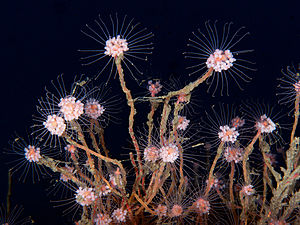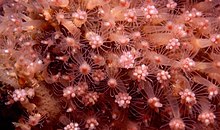Tubulariidae
| Tubulariidae | ||||||||||||
|---|---|---|---|---|---|---|---|---|---|---|---|---|

|
||||||||||||
| Systematics | ||||||||||||
|
||||||||||||
| Scientific name | ||||||||||||
| Tubulariidae | ||||||||||||
| Georg August Goldfuß , 1820 |
The Tubulariidae are a family of hydrozoa (Hydrozoa) from the tribe of the cnidarians (Cnidaria) that live exclusively in the sea . It is a small family with currently around 70 species in seven genera .
features
The hydroid polyps are solitary or colony-forming. The hydrocaulus is divided into the distal neck region, which is covered by a thin perisarc , and the proximal trunk. This can either be short and thick with bulbous, aboral processes, or long and cylindrical, or conical with a basal disk, or provided with stolons that are covered by a thicker perisarc. The perisarc of the neck region is excreted in a pit on the hydrant . The hydrant is broadly vase-shaped with two sets of tentacles . The oral tentacles are thread-like to pseudo-thread-like and arranged in one or more wreaths. They can be capitat or pearl-shaped, especially in juvenile specimens transitions occur. The aboral, thread-like or pseudo-thread-like tentacles are arranged in a single ring and sit on a more or less clearly developed pillow made of gastrodermal tissue. The gonophores develop above the aboral tentacles. Free medusas or fixed spore sacs are formed. Embryonic development takes place via an actinula larva, not a planula larva.
The medusa may have exumbrellar sternum cells ; but these can also be missing. The edge of the screen is straight or sloping. The mouth is usually rounded. There are four radial channels. The gonads completely cover the manubrium . One to four marginal tentacles are developed. Asexual jellyfish formation from marginal buds can occur. Ocelli are missing.
Geographical occurrence
The family is spread around the world.
Systematics
The family Tubulariidae was already established by Georg August Goldfuß in his work "Handbuch der Zoologie" in 1820, not as stated in the World Hydrozoa Datase by John Fleming in 1828 (as Tubulariadae). It currently includes seven genera:
- Family Tubulariidae
- Bouillonia Petersen, 1990
- Ectopleura L. Agassiz, 1862
- Hybocodon L. Agassiz, 1860
- Lobataria Watson, 2008
- Ralpharia Watson, 1980
- Tubularia Linnaeus, 1758
- Zyzzyzus Stechow, 1921
swell
literature
- Jean Bouillon, Cinzia Gravili, Francesc Pagès, Josep-Maria Gili and Fernando Boero: An introduction to Hydrozoa. Mémoires du Muséum national d 'Histoire naturelle, 194: 1-, Publications Scientifiques du Muséum, Paris 2006, ISBN 978-2-85653-580-6
- Marymegan Daly, Mercer R. Brugler, Paulyn Cartwright, Allen G. Collin, Michael N. Dawson, Daphne G. Fautin, Scott C. France, Catherine S. McFadden, Dennis M. Opresko, Estefania Rodriguez, Sandra L. Romano & Joel L. Stake: The phylum Cnidaria: A review of phylogenetic patterns and diversity 300 years after Linnaeus. Zootaxa, 1668: 127-182, Wellington 2007 ISSN 1175-5326 Abstract - PDF
- Paul Lassenius Kramp: Synopsis of the Medusae of the World. Journal of the Marine Biological Association of the United Kingdom, 40: 1-469, Plymouth, 1961 PDF Online
On-line
Individual evidence
- ↑ Georg August Goldfuß: Handbook of Zoology. First division. Nürnberg, Johann Leonhard Schrag, 1820 Online at archive.org (p. 87)
- ^ John Fleming: A history of British Animals, exhibiting the descriptive characters and systematical arrangement of the genera and species of Quadrupeds, Birds, Reptiles, Fishes, Mollusca, and Radiata of the United Kingdom; including indigenous, extirpated, and extinct kinds, together with periodical and occasional visitants. 565 pp., Bell & Bradfute, Edinburgh and James Duncan, London, 1828. Online at biodiversitylibrary.org (description Tubulariadae p. 552)
- ^ World Hydrozoa Database - Tubulariidae

